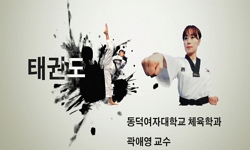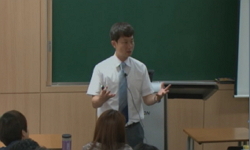Objective : In order for Taekwondo athletes to perform destructive kicking performance, they are expected to have Taekwondo-specific muscle properties such as high muscle strength and power. The purpose of this study was to investigate the joint angle...
http://chineseinput.net/에서 pinyin(병음)방식으로 중국어를 변환할 수 있습니다.
변환된 중국어를 복사하여 사용하시면 됩니다.
- 中文 을 입력하시려면 zhongwen을 입력하시고 space를누르시면됩니다.
- 北京 을 입력하시려면 beijing을 입력하시고 space를 누르시면 됩니다.

태권도 선수와 일반인의 등척성 무릎신전 토크-각도 관계 특성 비교 분석 = Comparison of Isometric Knee Extension Torque-Angle Relationship between Taekwondo Athletes and Normal Adults
한글로보기https://www.riss.kr/link?id=A101149834
- 저자
- 발행기관
- 학술지명
- 권호사항
-
발행연도
2015
-
작성언어
Korean
- 주제어
-
등재정보
KCI등재
-
자료형태
학술저널
- 발행기관 URL
-
수록면
275-281(7쪽)
-
KCI 피인용횟수
0
- DOI식별코드
- 제공처
-
0
상세조회 -
0
다운로드
부가정보
다국어 초록 (Multilingual Abstract)
Objective : In order for Taekwondo athletes to perform destructive kicking performance, they are expected to have Taekwondo-specific muscle properties such as high muscle strength and power. The purpose of this study was to investigate the joint angle-dependent force-producing property of Taekwondo athletes’ knee extensor muscles, which is one of the primary muscle groups involved in kicking performance. Method : Ten Taekwondo male athletes (age: 19.9±0.7 yrs, height: 180.6±6.2 cm, body mass: 75.9±8.9 kg, career: 9.2±2.9 yrs.) and 10 healthy male non-athletes (age: 26.3±2.6 yrs, height: 174.2±4.8 cm, body mass: 72.8±7.7 kg) participated in this study. Subjects performed maximum isometric knee extension at knee joint angles of 40°, 60°, 80°, and 100° (the full knee extension was set to 0°) with the hip joint angles of 0° and 80° (the full extension was set to 0°). During the contractions, knee extension torque using an isokinetic dynamometer simultaneously with muscle activities of the rectus femoris (RF), and the vastus lateralis (VL) and vastus medialis (VM) using surface electromyography were recorded. Based on the torque values at systematically different knee-hip joint angles, the joint torque-angle relationships were established and then the optimal joint angle for the knee extensor was estimated. Results : The results of this study showed that the isometric knee extension torque values were greater for the Taekwondo athletes compared with the non-athlete group at all hip-knee joint angle combinations (p<.05). When the hip joint was set at 80°, the peak isometric torque was greater for the Taekwondo athletes compared with the non-athlete group (313.61±36.79 Nm and 221.43±35.92 Nm, respectively; p <.05) but the estimated optimum knee joint angles were similar (62.33±5.71° and 62.30±4.67° for the Taekwondo athletes and non-athlete group, respectively). When the hip joint was set at 0°, the peak isometric torque was greater for the Taekwondo athletes compared with the non-athlete group (296.29±45.13 Nm and 199.58±25.23 Nm, respectively; p<.05) and the estimated optimum knee joint angle was larger for the Taekwondo athletes compared with the non-athlete group (78.47±5.14° and 67.54±5.77°, respectively; p<.05). Conclusion : The results of this study suggests that, compared with non-athletes, Taekwondo athletes have stronger knee extensor strength at all hip-knee joint angle combinations as well as longer optimum muscle length, which might be optimized for the event-specific required performance through prolonged training period.
참고문헌 (Reference)
1 Gordon, A. M, "The variation in isometric tension with sarcomere length in vertebrate muscle fibres" 184 (184): 170-192, 1966
2 Marginson, V, "The relationship between torque and joint angle during knee extension in boys and men" 19 (19): 875-880, 2001
3 Katz, B. K, "The relationship between force and speed in muscular contraction" 96 (96): 45-64, 1939
4 Hill, A. V., "The heat of shortening and the dynamic constants of muscle" 126 (126): 136-195, 1938
5 Herzog, W, "The biomechanics of muscle contraction : optimizing sport performance" 25 (25): 286-293, 2009
6 Lee, H. D, "Shift in optimal joint angle of the ankle dorsiflexors following eccentric exercise" 50 (50): 661-666, 2010
7 Brughelli, M, "Muscle architecture and optimum angle of the knee flexors and extensors: a comparison between cyclists and australian rules football players" 24 (24): 717-721, 2010
8 Herzog, W, "Moment-length relations of rectus femoris muscles of speed skaters/cyclists and runner" 23 (23): 1289-1296, 1991
9 Ullrich, B, "Moment-knee angle relation in well trained athletes" 29 (29): 639-645, 2008
10 Ullrich, B, "Moment-angle relations after specific exercise" 30 (30): 293-301, 2009
1 Gordon, A. M, "The variation in isometric tension with sarcomere length in vertebrate muscle fibres" 184 (184): 170-192, 1966
2 Marginson, V, "The relationship between torque and joint angle during knee extension in boys and men" 19 (19): 875-880, 2001
3 Katz, B. K, "The relationship between force and speed in muscular contraction" 96 (96): 45-64, 1939
4 Hill, A. V., "The heat of shortening and the dynamic constants of muscle" 126 (126): 136-195, 1938
5 Herzog, W, "The biomechanics of muscle contraction : optimizing sport performance" 25 (25): 286-293, 2009
6 Lee, H. D, "Shift in optimal joint angle of the ankle dorsiflexors following eccentric exercise" 50 (50): 661-666, 2010
7 Brughelli, M, "Muscle architecture and optimum angle of the knee flexors and extensors: a comparison between cyclists and australian rules football players" 24 (24): 717-721, 2010
8 Herzog, W, "Moment-length relations of rectus femoris muscles of speed skaters/cyclists and runner" 23 (23): 1289-1296, 1991
9 Ullrich, B, "Moment-knee angle relation in well trained athletes" 29 (29): 639-645, 2008
10 Ullrich, B, "Moment-angle relations after specific exercise" 30 (30): 293-301, 2009
11 Chen, T. C, "Intensity of eccentric exercise, shift of optimum angle and the magnitude of repeated bout effect" 102 (102): 992-999, 2007
12 Kulig, K, "Human strength curves" 12 (12): 417-466, 1984
13 Morgan, D. L, "Early events in stretch-induced muscle damage" 87 (87): 2007-2015, 1999
14 Savelberg, H. H, "Contribution of mono and biarticular muscles to extending knee joint moments in runners and cyclists" 94 (94): 2241-2248, 2003
동일학술지(권/호) 다른 논문
-
- 한국운동역학회
- 류지선 ( Ji Seon Ryu )
- 2015
- KCI등재
-
테니스 양손 백핸드 드라이브 스트로크 시 볼 방향성에 따른 수평회전운동 비교분석
- 한국운동역학회
- 서국은 ( Kook Eun Seo )
- 2015
- KCI등재
-
- 한국운동역학회
- 박종율 ( Jong Yul Park )
- 2015
- KCI등재
-
착지 높이와 무릎관절 근육 피로가 착지 후 방향 전환 동작 시 하지관절의 움직임에 미치는 영향
- 한국운동역학회
- 김유경 ( You Kyung Kim )
- 2015
- KCI등재
분석정보
인용정보 인용지수 설명보기
학술지 이력
| 연월일 | 이력구분 | 이력상세 | 등재구분 |
|---|---|---|---|
| 2022 | 평가예정 | 계속평가 신청대상 (계속평가) | |
| 2021-12-01 | 평가 | 등재후보로 하락 (재인증) |  |
| 2018-01-01 | 평가 | 등재학술지 유지 (등재유지) |  |
| 2015-01-01 | 평가 | 등재학술지 유지 (등재유지) |  |
| 2011-01-01 | 평가 | 등재학술지 유지 (등재유지) |  |
| 2009-01-01 | 평가 | 등재학술지 유지 (등재유지) |  |
| 2007-01-01 | 평가 | 등재학술지 유지 (등재유지) |  |
| 2004-01-01 | 평가 | 등재학술지 선정 (등재후보2차) |  |
| 2002-01-01 | 평가 | 등재후보학술지 선정 (신규평가) |  |
학술지 인용정보
| 기준연도 | WOS-KCI 통합IF(2년) | KCIF(2년) | KCIF(3년) |
|---|---|---|---|
| 2016 | 0.76 | 0.76 | 0.75 |
| KCIF(4년) | KCIF(5년) | 중심성지수(3년) | 즉시성지수 |
| 0.79 | 0.68 | 0.864 | 0.14 |





 ScienceON
ScienceON KISS
KISS



